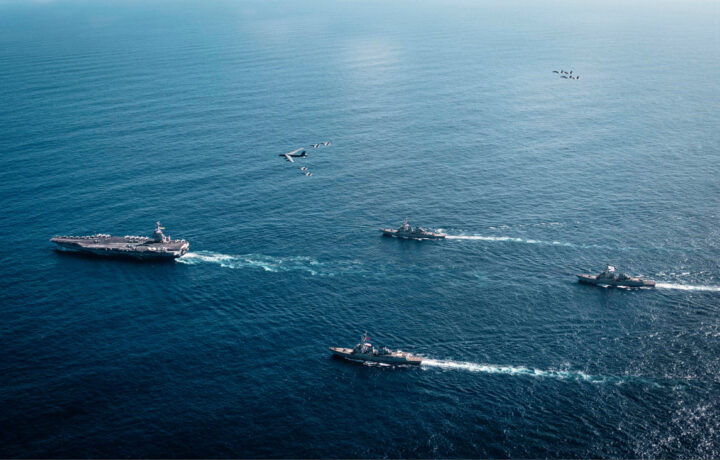The buildup of U.S. military forces to support the newly announced Operation Southern Spear has continued, and on Sunday, the United States Navy’s largest warship arrived in the region.
The U.S. Navy also reopened Naval Station Roosevelt Roads, which had been closed in 2004. It is now one of five locations where United States military forces are operating on the island territory of Puerto Rico, possibly in advance of combat operations in Venezuela.
Base Named for FDR Before He Became President
Located on the eastern coast of Puerto Rico, the base was named after then-Assistant Secretary of the Navy Franklin D. Roosevelt, who had surveyed the location in 1919. It went on to become one of the most extensive naval facilities in the world, with more than 100 miles of paved interior roads.
It was commissioned as the U.S. Naval Operations Base in 1943. In 1957, Roosevelt Roads was redesignated as a Naval Station.
It remained in use throughout the Cold War, but was shuttered with the closure of the Naval Training Range in Vieques. The United States Special Operations Command (SOCOM) South relocated from Roosevelt Roads to Homestead Air Reserve Base in Miami-Dade County, Florida, while U.S. Naval Forces Southern Command (USNAVSO) moved to Mayport Naval Station, near Jacksonville.
Additionally, Naval Mobile Construction Battalion (NMCB) 74 (Seabees) relocated from Roosevelt Roads to Little Creek, VA.
It is unclear what is being based at Naval Station Roosevelt Roads, but the facility could support training operations or even host warships deployed to the region.
“With a remarkable expanse of coastal oceanfront property, Naval Station Roosevelt Roads is likely one of the largest coastal properties under single ownership in Puerto Rico. In dimensions, the Naval Station measures nearly five miles across (northeast to southwest) and nearly four miles wide (northwest to southeast). The Station’s unique and very large bay, called ‘Ensenada Honda’ is a large and naturally protected harbor measuring roughly 1.25 miles wide by 2.15 miles long,” explained the Naval Facilities Engineering Systems Command website.
The Ford Has Arrived
On Sunday, the Gerald R. Ford Carrier Strike Group, led by the nuclear-powered supercarrier USS Gerald R. Ford (CVN-78), transited the Anegada Passage and entered the Caribbean Sea, further bolstering the build-up of U.S. forces in the U.S. Southern Command (SOUTHCOM) area of responsibility.
The Ford CSG will support President Donald Trump’s directive to dismantle Transnational Criminal Organizations and counter narco-terrorism in defense of the United States, the U.S. Navy announced.
“Through unwavering commitment and the precise use of our forces, we stand ready to combat the transnational threats that seek to destabilize our region,” said Adm. Alvin Holsey, Commander, SOUTHCOM. “The USS Gerald R. Ford Carrier Strike Group’s deployment represents a critical step in reinforcing our resolve to protect the security of the Western Hemisphere and the safety of the American Homeland.”
The nuclear-powered aircraft carrier and the other assets of the CSG join the joint forces already operating in the region, including the Iwo Jima Amphibious Ready Group and its embarked Marine Expeditionary Unit.
CVN-78 departed her homeport of Norfolk, VA, in late June and was deployed to conduct multi-domain strike group operations in the Atlantic Ocean before transiting east into the U.S. Sixth Fleet area of operations, sailing above the Arctic Circle and throughout the Mediterranean Sea with multiple Allies and partners, participating in NATO’s Neptune Strike 25-2 and 25-3 enhanced vigilance activities.
During this deployment, USS Gerald R. Ford has made port calls in Croatia, France, Germany, Norway, and Spain.
There had been speculations that CVN-78, the largest and most capable carrier in the U.S. Navy’s fleet, would be dispatched to the eastern Mediterranean to ensure the peace between Israel and Hamas holds. Instead, Secretary of Defense Pete Hegseth ordered the flattop to the Caribbean.
With the departure of USS Nimitz (CVN-68) from the Red Sea last month, it marked the first time in two years that the U.S. Navy has maintained a carrier presence in the Middle East.
Cartel de los Soles to Be Designated Foreign Terrorists
USS Gerald R. Ford also arrived in the region just hours before Secretary of State Marco Rubio announced Sunday night that the United States would designate Cartel de los Soles, a group that the Trump administration has claimed is headed by Venezuela’s president, as a foreign terrorist organization.
The designation is reportedly set to take effect on November 24.
“Neither Maduro nor his cronies represent Venezuela’s legitimate government,” Secretary Rubio said. “Cartel de los Soles, by and with other designated FTOs, including Tren de Aragua and the Sinaloa Cartel, are responsible for terrorist violence throughout our hemisphere as well as for trafficking drugs into the United States and Europe.”



